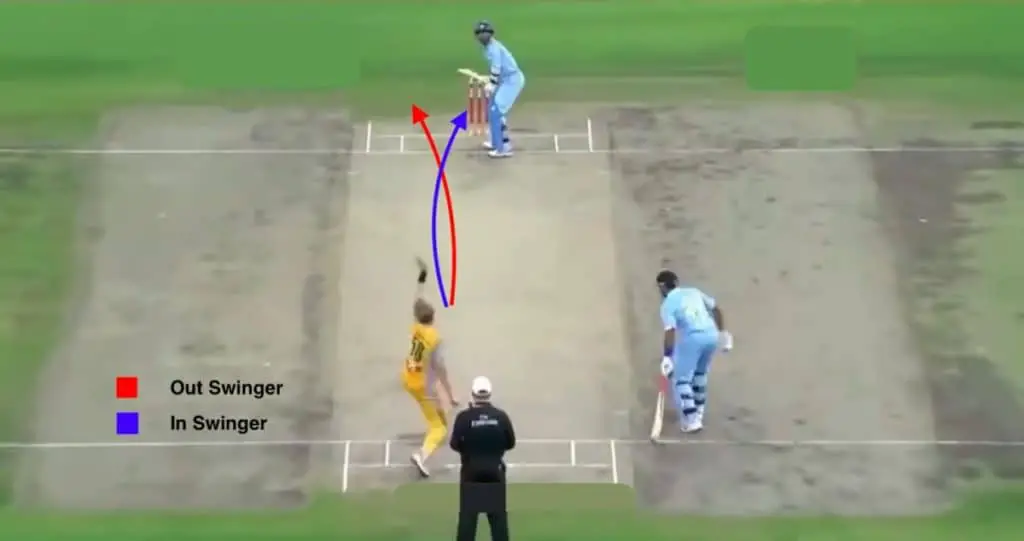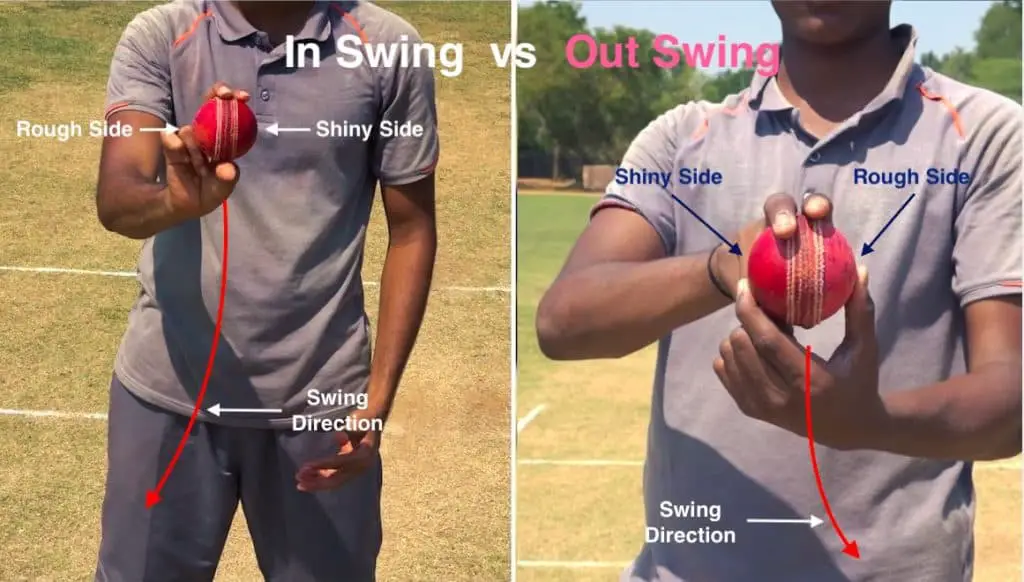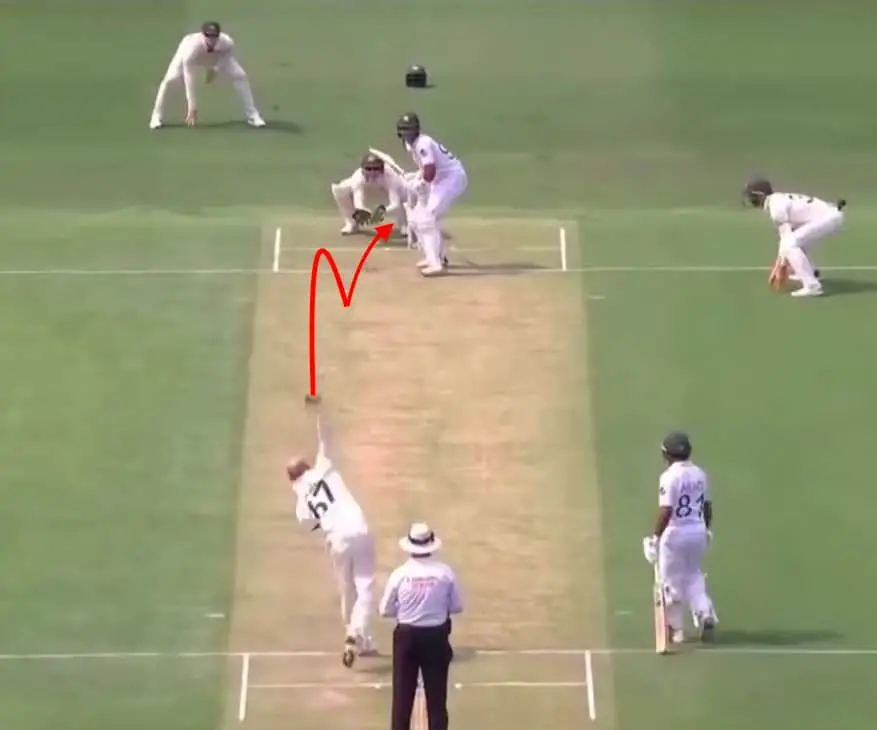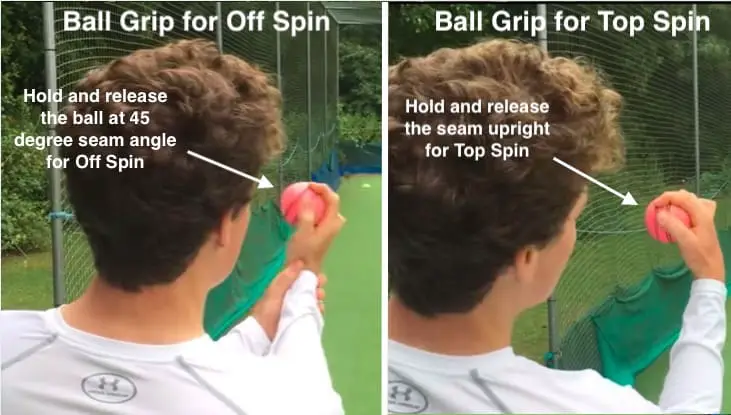For a bowler to be successful in international cricket, he need to know how to bowl different types of deliveries. There are so many different variations that a bowler can bowl. In today’s post, we shall look at how many different types of bowling exists and what these are!
The first thing that we need to know is that there are two main types of bowlers in Cricket. These are –
- Fast Bowler – These can also be of two types
- Fast Pace
- Medium Pace
- Spin Bowler – There are also two types of spin bowlers. These are –
- Leg Spin
- Off Spin
Even though there are mainly two types of bowlers, there are a total of 21 different types of bowling that exist in cricket! This means, a bowler may primarily be a leg spinner but there are several different types of deliveries that he may be able to bowl.
Let’s learn about all these 21 different types of bowling in detail.
Different Types of Fast Bowling –
Fast bowlers (or pace bowlers) mainly depend on the speed at which they ball in order to deceive the batsman. As they bowl at a really fast speed, even a slight movement of the ball in the course of its path can easily beat the batsman and lead to his dismissal.
In addition to bowling at high speeds, the key skill of a fast bowler is to be able to generate this slight movement after they have released the bowl from their hand. This deviation from the path is useful to fox the batsman and get him out.
There are a number of different ways a bowler can deceive a batsman. These are also known as different types of fast bowling –
1. In Swinger
A cricket ball is known to swing when the ball moves in the air after it has been released from the hands of the bowler.
Swing bowling is an art. It is a skill that all fast bowlers need to master. There are predominantly three types of swing bowling, and in swinger is one of them.

In order to bowl an in swing delivery, the bowler has to hold the rough side of the bowl towards the batsman. This rough side of the ball creates turbulence in the air and is able to swing due to the variance in the pressure created due to the rough and smooth sides of the ball.
The above video showcases some of the best examples of in swing bowling by different bowlers in cricket. Do watch the video to understand exactly what an in swing bowling looks like.
2. Out Swing
Another type of swing bowling that fast bowlers often choose to bowl is an Out Swing delivery. Out swing deliveries are the ones that move away from the batsman.
While the in swing bowling is bowled with the intention of hitting the stumps or getting a batsman out LBW, an out swing delivery is bowled by the bowler often to set up a batsman for an in swing delivery.
By bowling a few out swing deliveries, a batsman may think that the next delivery is also going to go away from him. However, the bowler then chooses to bowl and in swing delivery and get the batsman out.
Thus, out swing bowling is very useful for this kind of set up. It can often also make the batsman play the ball, but due to the movement, the ball can hit the bat and end up with the slips fielder.
3. Reverse Swing
So reverse swing is a bit tricky. In order to truly understand what reverse swing is, one needs to understand how a cricket ball typically swings.

A cricket ball generally swings in the direction of the rough side of the ball (as indicated from the image above). This is the normal behaviour of the ball.
However, reverse swing is an almost magical delivery as it defies the above logic. A reverse swinging delivery can be bowled only when the cricket ball gets old.
When a cricket ball gets old, it often starts showcasing reverse swing. What reverse swing means is that the ball actually starts swinging in the direction of the shiny side. In other words, a reverse swing occurs when the ball starts to move in the reverse direction of how it is typically expected to swing.
If swinging a cricket ball requires skill, reverse swing is perfection of swing bowling! Some bowlers are exceptional at it, while others aren’t.
4. Bouncer
A bouncer is a type of delivery that is pitched short. In other words, a delivery is known as a bouncer when a bowler intentionally makes the ball bounce nearly half way on the pitch and, as a result, the ball reaches the batsman at a shoulder or head level height.
A well guided bouncer with some element of surprise can be a potent weapon for a fast bowler. This is because when a ball suddenly comes towards the batsman’s face or chest at high speeds, it makes the batsman really uncomfortable.
A bouncer can often affect the confidence level of the batsman and many a times also lead to the batsman getting out!
Countries such as Australia, South Africa or West Indies are well known for their strong built bowlers who can bowl effective bouncers at great pace. Even the cricket pitch in such countries are made to support fast bowlers.
5. Slower Ball
A slower ball is yet another useful type of bowl that helps a fast bowler take wickets.
The objective of a slower ball is to deceive the batsman with sudden change in the speed of the delivery in the air rather than scaring the batsman with really fast speed.
This is how a slower ball works – a fast bowler is generally expected to bowl a delivery at high speeds which usually vary from around 130 kmph (kilo meters per hour) to about 150 kmph. (That’s close to about 80 to 90 miles per hour). Some bowlers ball even faster than that. In order to play such fast deliveries, the batsman needs get in a position to play equally quickly.
However, when the bowler suddenly drop the speed to around 100 – 110 kmph, a batsman who is not expecting the ball to be slow, gets ready much earlier and continues with his shot even though the ball just doesn’t arrive As a result, the batsman gets beaten by the change in pace and he ends up getting out!
The above video showcases some interesting examples of slower balls bowled by the bowler in cricket.
6. Yorker
This is another very useful type of bowling in the armoury of a fast bowler.
A yorker is basically a type of delivery when the ball is bowled right at the base of the stumps of the batsman. Often, the aim of the bowler with the yorker is to bowl right at the toes of the batsman.
A yorker is often one of the most difficult deliveries to defend or hit. The main reason for this is because it is difficult for a batsman to reach the ball with his bat as a yorker often hits the bottom of the bat. As a result, more often than not, a batsman ends up missing the ball leading to his dismissal.
If a yorker is bowled at a really fast speed, it can be highly effective.
As you may have seen in the above video, defending a yorker requires a quick reaction time from the batsman which is often difficult.
In order to make it even more difficult for the batsman to play the yorker, good fast bowlers bowl swinging yorkers. For a swinging yorker, the bowler often swings the ball back into the batsman (an in swing delivery) while bowling it at the toes of the batsman. This makes it almost unplayable.
7. Off cutter
Off cutter is another type of bowling that a fast bowler will use at their discretion.
An off cutter is essentially a type of a slower bowl. However, the way it is bowled by the bowler makes it a different type of delivery than a slower ball.
Unlike the slower ball, the purpose of this delivery is not necessarily to beat the batsman with the change in speed, but with the change in the direction of the ball after it bounces on the pitch.
The easiest way to understand an off cutter is to think of it as a fast bowler deciding to ball off spin bowling.
In order to bowl an effective off cutter, a fast bowler generally rolls the fingers over the seam (just as an off spin bowler would) thereby resulting in the slower speed and spin of the ball.
The video above showcases exactly how to bowl an off cutter in cricket.
8. Leg cutter
Just like the off cutter, the leg cutter is another variation of the slower delivery used by the fast bowlers.
The goal of using the leg cutter is not necessarily deceiving the batsman with the speed at which the ball is bowled, but also the change in direction after the ball bounces on the pitch.
An easier way to understand a leg cutter is to think of it as a fast bowler trying to bowl leg spin bowling.
It is called a cutter as the ball cuts after it bounces on the pitch
In the video above, West Indies great fast bowler Malcom Marshall bowls a beautiful leg cutter.
It is not always necessary that a fast bowler changes the speed of the ball drastically. Although, when bowling off cutter or a leg cutter, the speed of the ball will automatically drop and won’t be as fast the bowler typically bowls.
9. Knuckleball
The Knuckleball is another version of a slower ball that fast ballers often use.
The objective of bowling the knuckleball is similar to that of a slower ball which is to defeat the batsman with the change in the speed of the ball.
However, the main difference between the slower ball and the knuckle ball is position in which the ball is held in the hands. With slower balls, there is often one finger across the seam. This can be seen by the batsman at the other end of the pitch, and when spotted by the batsman, it defeats the surprise element.
Therefore, a knuckleball is used. For the knuckleball to be bowled, the bowler needs to hold the between the tip of the index and the middle finger supported by the tip of the thumb (much like holding the ball with the bowler’s knuckles)
The advantage with the knuckle ball is that the position of the ball in the bowler’s hand from the batsman’s angle makes it seem like the bowler is holding the ball normally!
Check out some of the examples of Knuckle Ball in cricket in the video below.
Much like any other delivery in cricket, the knuckleball also works mainly on deception by the bowler and the element of surprise to make the batsman play an incorrect shot.
10. Beamer
What the ball bowled by the bowler reaches the batsman directly at about chest or head high, it is considered a beamer.
A beamer is a type of bowl that is often not intentional. Furthermore, when it is intentional, a bowler may be penalised for bowling a beamer. Sometimes, a bowler may bowl a beamer on purpose out of frustration, while the other times it can be an honest mistake of a ball slipping out of a bowler’s hand.
A beamer is considered an illegitimate delivery. This means, if a bowler bowls a beamer intentionally or unintentionally, it is given a no ball and the ball is not counted. Any runs scored of such a delivery are added to the batsman and the team’s total.
BONUS VIDEO on Brett Lee explaining the different types of Fast Bowling he used in International Matches
Before we move on to other types of bowling in cricket, I would just like to share a bonus video from Australian Fast Bowler Brett Lee explaining the different types of fast bowling he bowled during his career. He also shares a few examples of each of the type of bowls he talks about. Give it a watch!
Different Types of Spin Bowling
As we mentioned in the beginning of the post, there are two types of bowlers. We’ve already covered the various types of bowling or deliveries bowled by a fast bowler.
Let’s look at some of the types of deliveries bowled by a spin bowler.
Off Spin Bowling Types
As you may be aware, when a bowler bowls at a slower pace, he generally tries to make the ball spin in order to defeat the batsman and get him out. There can be two types of spin bowling. Let’s first talk about the off spin bowling types.
11. Off Break
The off break, which is otherwise also known as off spin, is the most standard type of bowling for an off spin bowler. This is their daily bread and butter type of a bowl.

The idea of off break or an off spin, is to make the ball spin towards the stumps (for a right hand batsman). An off break ball will be typically pitched outside the off stump and then made to spin back into the stumps of the batsman
As I mentioned, this is the most basic delivery that an off spin bowler bowls.
12. Top Spin for an Off Spinner
The top spin is an important variation that most off spin bowlers bowl.

(image source – wecricket)
The different between the top spin and the off break is not just in the way the ball is gripped by also on how much deviation the ball takes as compared to an off break.
The top spin often very deceptive as the batsman expects the ball to turn very rapidly towards him, however, it in fact increases the speed after bouncing thereby going past the batsman.
13. Arm Ball
The Arm Ball, as the name suggests, uses some extra effort from the arm of the bowler. It is essentially a much quicker delivery than a spinner usually bowls.
An arm ball can be compared to a slower ball of the fast bowler. The purpose of the two deliveries is the same – to defeat the batsman with the difference in the speed of the bowling.
Most spinners usually bowl in a speed range of about 80 kmph to about 96 kmph (approximately 50 miles per hour to 60 miles per hour). Thus, most batsman start expecting the ball to be in the same speed range. However, if a spin bowler is able to bowl much faster with the same action and a bit of surprise, the chances of getting the batsman out is much higher.
For a spin bowler to bowl the ball much faster with the exact same action requires mainly to move the arm much faster and use the strength of his shoulders. This is the main reason why this variation of spin bowling is known as the arm bowl.
Some spin bowlers are able to bowl the arm ball at around 100 – 105 kmph, while a bowlers like Shahid Afridi and Andrew Sydmonds were able to bowl it at around 115-125 kmph! That’s almost as fast as a medium pace fast bowler!
14. The “Doosra”
The “Doosra” (meaning in Hindi – the other one), was invented by Pakistan Off Spin bowler Saqlain Mustaq.
Saqlain Mustaq was an off spin bowler. But, he came up with a clever way to deceive the batsman with the doosra.
The doosra looked like a typical off spin bowl when it left the hands of the bowler, however, after it bounced on the pitch it actually went in the opposite direction than it was supposed to go. The ball landed on the pitch and spun from right to left (like a leg spin) instead of spinning from left to right (like an off spin).
This left the batsman completely confused, and they would often end up missing the ball completely or end up with a mis-hit.
The above video showcases some very interesting examples of the wickets taken by Saqlain Mustaq using the “Doosra”.
15. Carrom Ball
The Carrom Ball is a unique style of spin bowling deployed by an off spinner. It is called a carrom ball because of the grip of the ball.
While bowling the carrom ball, the bowler typically holds the ball between the thumb and the middle finger. The ball then has to essentially be squeezed out of the hand of the bowler much like flicking a carrom disc in the game of carrom board.
It is a particularly difficult delivery to bowl.
Although the delivery was first brought into use in the early 1940s with the same grip hold on the ball, it was reintroduced by Ajantha Mendis of Sri Lanka in 2008.
The carrom ball was later adopted by Indian Spinner Ravichandran Ashwin among other bowlers.
16. The “Teesra”
The “Teesra”, much like the “Doosra” was also introduced by Saqlain Mustaq of Pakistan. It is another variation of spin bowling adopted by off spin bowlers.
To bowl the teesra, the ball is held in a normal grip by an off spinner. However, at the point of release of the ball, the bowler moves the wrist but does not roll the fingers.
This creates an illusion that the ball is going to spin a lot. However, it simply doesn’t spin and foxes the batsman.
The Teesra works similar to how a leg spinner bowls a slider (which we will learn more about in detail below in the post)
Types of Leg Spin Bowling
A leg spin, as opposed to an off spin, occurs when the ball moves from right to left (from the bowler’s viewpoint) after bouncing on the pitch.
Leg spin is another well known type of spin bowling. Let’s learn the different types of leg spin bowling in detail below.
17. Leg Break
Just as the off break is the usual delivery of an off spin bowler, the leg break is also the go-to delivery for a leg spin bowler! The leg break is also known as leg spin.
The above video is a classic example of the direction in which a typical leg spin delivery moves.
A leg break is often one of the most difficult deliveries to play for a right hand batsman as it is moving away from the batsman. However, it can be equally difficult for a left handed batsman to play as well. Andrew Strauss of England learned this the hard way. Watch the video below to know more.
18. Top Spin for a Leg Spinner
The Top Spin for a leg spinner is an extremely useful variation. The top spin for a leg spinner works similar to the top spin from an off spinner. The difference is a bit in the grip of the ball.
What makes top spin really potent is that because of the nature of the release of the ball, the ball loops in the air, but drops much faster and shorter than expected and often bounces much more than anticipated by the batsman. As we have already learned several times, any amount of unexpected spin or bounce is really effective in getting the batsman out!
19. Googly
The Googly is a type of bowling by leg spin bowlers. In essence, the purpose of a googly is similar to the doosra by an off spin bowler.
The objective of a googly for a leg spinner is to deceive the batsman by spinning the ball in the other direction than what is expected.
Typically, a leg spin bowler bowls a lot of leg break. This means, most of his deliveries spin from the leg side towards the off side away from the batsman (from right to left side of the pitch). However, the Googly actually goes in the other direction (from left to right of the pitch).
The Googly, once mastered by a leg spinner and when used sparingly, can yield in a lot of wickets for a let spin bowler.
20. Flipper
A flipper, when used correctly, is an extremely potent delivery for a leg spin bowler.
It is one of the most difficult deliveries to master. The idea behind the flipper is similar to the top spin. However, it doesn’t bounce as much as a typical top spin ball would. When a flipper is bowled by a leg spinner, it seems to the batsman that it would be a short of length delivery, however, it just doesn’t bounce as much and skids through getting the batsman out LBW or Bowled.
The Flipper is best understood with an example. Let’s watch the below video which showcases Shane Warne bowling a flipper
As you can see in the above video, Shane Warne sets up the batsman by bowling two short pitched deliveries. Then, he bowls a flipper making the batsman think that the bowl is again a short pitched delivery. Whereas, the ball just remains low and skids through, thus deceiving the batsman!
There have been several leg spin bowlers who have used the delivery with great effect! Shane Warne of Australia bowled it really well, whereas Anil Kumble of India and Abdul Qadir of Pakistan made it their signature delivery!
21. Slider
The slider is another interesting variation used by the leg spin bowlers.
It was thought to have been introduced by Shane Warne, however, it was actually used during the early 1960s by multiple bowlers.
The slider actually looks just like the leg break from the angle of the batsman. This is because the grip is exactly similar to that of the leg break.
However, the movement of the wrist and the angle of release is slightly different from the leg break. As a result, the ball, instead of spinning like a leg break, actually just holds the line and slides on to the batsman.
Mastering the Slider requires a lot of practice. An easy way to master the slider is to check the bowling action in front of the mirror to make sure that the grip does indeed deceive the batsman.
BONUS Video of Shane Warne on Leg Spin Bowling types
Shane Warne, the master of leg spin bowling, showcases a few different types of leg spin bowling that he bowled over the years in his international career. Do watch the video!

